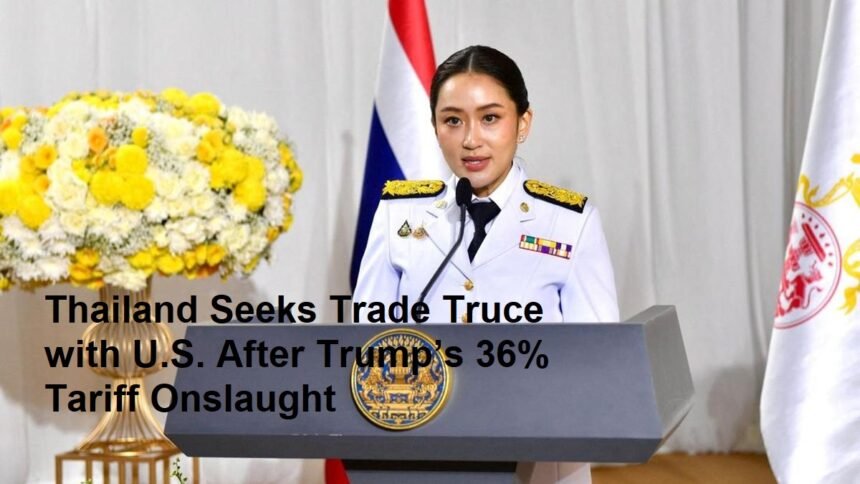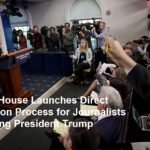In a bid to defuse escalating trade tensions, the Thai government announced plans to significantly increase imports of U.S. goods—including energy, agricultural products, and aircraft—following former President Donald Trump’s decision to impose 36% reciprocal tariffs on select Thai exports. Prime Minister Paetongtarn Shinawatra framed the move as a “strategic countermeasure” to cushion the blow to Thailand’s economy, while positioning the Southeast Asian nation for smoother long-term trade relations with the United States. The tariffs, set to take effect on April 9, target key Thai industries such as automotive parts, electronics, and seafood, intensifying pressure on a nation already grappling with sluggish growth and geopolitical uncertainty.
The Tariff Trigger: Trump’s America-First Revival
The 36% tariffs mirror Trump’s aggressive trade policies during his 2017–2021 presidency, which prioritized rebalancing trade deficits through punitive measures. Thailand, which exported $48.5 billion worth of goods to the U.S. in 2023, now joins a list of nations—including China, the EU, and Canada—that have faced Trump’s tariff tactics. The U.S. Trade Representative (USTR) justified the tariffs as retaliation for Thailand’s “unfair” import restrictions on American agricultural products and intellectual property concerns. However, analysts argue the move aligns with Trump’s broader agenda to pressure allies into bilateral deals favoring U.S. interests.
Thailand’s Counterstrategy: Buying American to Buy Time
To mitigate the tariffs’ impact, Thailand’s cabinet approved a sweeping plan to ramp up imports of U.S. goods across three critical sectors:
- Energy: Thailand will increase purchases of liquefied natural gas (LNG) and crude oil from U.S. suppliers, aiming to diversify its energy portfolio amid rising global demand. A $2 billion deal with Cheniere Energy, a leading U.S. LNG exporter, is already in negotiation.
- Agriculture: The government pledged to import $1.5 billion worth of American soybeans, wheat, and dairy products annually, addressing domestic shortages caused by climate disruptions and supply chain bottlenecks.
- Aerospace: Thai Airways is finalizing an order for 12 Boeing 787 Dreamliners, part of a broader fleet modernization program estimated at $3.8 billion.
Prime Minister Shinawatra, daughter of exiled former leader Thaksin Shinawatra, emphasized the “mutual benefits” of the strategy: “By strengthening imports from the U.S., we aim to stabilize bilateral ties and create a foundation for fairer negotiations.” The move also carries political undertones, as her Pheu Thai party seeks to reaffirm Thailand’s alignment with Western democracies amid growing Chinese influence in the region.
Thailand’s Demands: Investment Privileges and Export Relief
In exchange for boosting U.S. imports, Bangkok is pressing Washington for concessions to protect its own economic interests. Key requests include:
- Fast-Tracked Investor Privileges: Thai officials want U.S. authorities to grant expedited approvals and tax incentives for Thai investors in American tech, renewable energy, and manufacturing sectors. This would mirror benefits currently afforded to investors from treaty allies like Japan and Australia.
- Reduced Non-Tariff Barriers: Thailand seeks the removal of stringent sanitary, phytosanitary, and labeling regulations that have long hindered exports of Thai processed foods, textiles, and electronics to the U.S.
Commerce Minister Phumtham Wechayachai warned that failure to address these demands could lead Thailand to “reassess its cooperation” on broader issues, including U.S. military access to strategic Thai bases.
Domestic Risks and Global Implications
While the import surge may temporarily appease Trump, critics caution that Thailand’s economy faces significant risks. Increasing reliance on U.S. energy and agriculture could destabilize local industries, such as Thailand’s rice and palm oil sectors, which already struggle against cheaper Vietnamese and Indonesian competitors. Meanwhile, the Boeing deal has drawn backlash from opposition lawmakers, who argue taxpayer funds should prioritize domestic infrastructure over foreign aircraft.
Globally, Thailand’s maneuvering reflects a broader trend of nations adapting to the resurgence of protectionism. Similar to the EU’s digital tax retaliation against U.S. tech giants in 2020, Thailand is leveraging targeted trade measures to assert leverage. However, unlike China or the EU, Thailand lacks the economic clout to wage a prolonged tariff war, making cooperation its only viable path.
A Fragile Balancing Act
The Shinawatra government’s strategy hinges on the assumption that Trump’s tariff threat is a negotiating tactic rather than a fixed policy. With U.S. elections looming in November, Bangkok hopes to secure interim agreements before potential political shifts in Washington. Yet, experts like Kiatipong Ariyapruchya, a senior economist at the World Bank, warn that Thailand’s approach is a “stopgap solution” that fails to address structural trade imbalances.
As April 9 approaches, Thailand’s gamble underscores the precarious position of mid-sized economies in an era of great-power rivalry. By buying American, Bangkok aims to buy time—but whether this truce evolves into lasting peace remains uncertain. For now, the world watches as another nation navigates the high-stakes game of Trump-era trade diplomacy.












